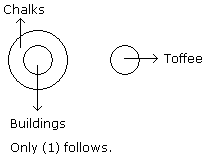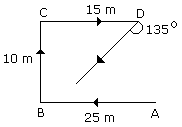Discussion
Home ‣ Verbal Reasoning ‣ Statement and Conclusion See What Others Are Saying!
- Question
- Statement:
All over the world there is rat race for achieving higher growth rate of the GDP, but the economic benefits are seldom calculated vis-a-vis the social cost incurred in the from of degradation of environment.
Conclusions :
I. Higher growth rate achieved by degradation of environment is not good.
II. Other modes of achieving higher growth rate is more beneficiary than the current mode.
Options- A. if only conclusion I follows
- B. if only conclusion II follows
- C. if either I or II follows
- D. if neither I nor II follows, and
- Correct Answer
- if neither I nor II follows, and
ExplanationI is an assumption that has led the speaker to show his concern in the statement. II can also not be concluded. We don't know about the benefits/losses of alternative modes.
- 1. Arrange the words given below in a meaningful sequence.
1. Tree 2. Seed 3. Flowers 4. Fruit 5. Plant
Options- A. 5, 2, 1, 3, 4
- B. 2, 5, 1, 4, 3
- C. 2, 5, 1, 3, 4
- D. 2, 5, 3, 1, 4 Discuss
- 2. Arrange the words given below in a meaningful sequence.
1. Income 2. Status 3. Education 4. Well-being 5. Job
Options- A. 3, 1, 5, 2, 4
- B. 1, 3, 2, 5, 4
- C. 1, 2, 5, 3, 4
- D. 3, 5, 1, 2, 4 Discuss
- 3. Md. Yusuf was born on 29 th January 1975. He has secured 55% marks in graduation and 52% marks in the selection process. He has also secured 68% marks in post graduate diploma Marketing Management. He has been working for the Marketing Division of an Organization.
Options- A. if the case is to be selected
- B. if the case is to be referred to the Head-Marketing Division
- C. if case is to be referred to GM - Marketing
- D. if the candidate is not to be selected Discuss
- 4. Miss Deepa Suresh is 45 years old and lives in Paonta Sahib, which is about 15 kilometres from Dehradun city. She has been a member of the Doon Club for the last 7 years. She won awards in three events last year.
You need to take a decision whether:
Options- A. The person can be appointed as the secretary of the Doon Club.
- B. The person cannot be appointed as the secretary of the Doon Club.
- C. Sufficient information is not available to take the decision.
- D. The candidate has to be referred to the selection committee. Discuss
- 5. Amit Saxena was born on 25th July 1973. He has been working in the personnel deptt. Of an organization for the past eleven years after completing his postgraduate diploma in HR with 70% marks. He has secured 60% marks in both graduation selection process.
Options- A. if the candidate is to be selected
- B. if the candidate is not to be selected
- C. if the information provided is inadequate to take a decision
- D. if the case is to be referred to the Director-Personnel Discuss
- 6. Arrange the words given below in a meaningful sequence.
1. Rainbow 2. Rain 3. Sun 4. Happy 5. Child
Options- A. 4, 2, 3, 5, 1
- B. 2, 3, 1, 5, 4
- C. 4, 5, 1, 2, 3
- D. 2, 1, 4, 5, 3 Discuss
- 7. A word is represented by only one set of numbers as given in anyone of the alternatives. The sets of numbers given in the alternatives are represented by two classes of alphabets as in two matrices given below. The columns and rows of Matrix I are numbered from 0 to 4 and that of Matrix II are numbered from 5 to 9. A letter from these matrices can be represented first by its row and next by its column, e.g. B can be represented by 04, 11, 23 etc. and N can be represented by 59, 66, 78 etc. Identify the set for the word M I L K.
Options- A. 12, 67, 32, 99
- B. 31, 86, 33, 87
- C. 21, 76, 32, 95
- D. 10, 67, 42, 88 Discuss
- 8. Among P, Q, R, S, and T each having a different weight, R is heavier than S but lighter than T. P is lighter than S. Who among them is the heaviest?
Options- A. T
- B. Q
- C. Either T or Q
- D. Data inadequate Discuss
- 9. Statements: All buildings are chalks. No chalk is toffee.
Conclusions:
- No building is toffee
- All chalks are buildings.
Options- A. Only (1) conclusion follows
- B. Only (2) conclusion follows
- C. Either (1) or (2) follows
- D. Neither (1) nor (2) follows
- E. Both (1) and (2) follow Discuss
- 10. P started from his house towards west. After walking a distance of 25 m. He turned to the right and walked 10 m. He then again turned to the right and walked 15 m. After this he is to turn right at 135o and to cover 30 m. In which direction should he go?
Options- A. West
- B. South
- C. South-West
- D. South-East Discuss
More questions
Correct Answer: 2, 5, 1, 3, 4
Explanation:
| Seed | Plant | Tree | Flowers | Fruit |
| 2 | 5 | 1 | 3 | 4 |
Correct Answer: 3, 5, 1, 2, 4
Explanation:
| Education | Job | Income | Status | Well-being |
| 3 | 5 | 1 | 2 | 4 |
Correct Answer:
Explanation:
Following are the conditions for selecting Chief Manager ? Marketing in an organization.
The candidates must
(i) be at least 35 years old as on 1?2?2010.
Md. Yusuf was born on 29th January 1975.
(ii) have secured at least 55% marks in graduation.
He has secured 55% marks in graduation.
(iii) have secured at least 60% marks in post ? graduate degree/diploma in Marketing Management.
He has also secured 68% marks in post graduate diploma Marketing Management.
(iv) have post ? qualification work experience of at least 10 years in the marketing Division of an organization.
He has been working for the Marketing Division of an Organisation.
Working year information is not given in question.
(v) have secured at least 50% marks in the selection process.
He has secured 52% marks in the selection process.
Correct Answer:
Explanation:
Miss Deepa Suresh does not fulfil all the conditions given in the question, and therefore her case will be referred to the president of the club.
Correct Answer: if the case is to be referred to the Director-Personnel
Explanation:
As per given following criteria in the question the candidates must
(i) be a graduate with at least 50% marks.
He has secured 60% marks in graduation.
(ii) have a postgraduate degree/diploma in Personnel Management/HR with at least 60% marks.
He had done post-graduating diploma in HR with 70% marks.
(iii) not be more than 35 years as on 1. 6. 2009.
Amit Saxena was born on 25th July 1973.
or
(a) at (iii) above, but has post - qualification work experience of at ten years, the case is to be refereed to the Director - Personnel.
He has been working in the personnel deptt. Of an organization for the past eleven years
(iv) have post qualification work experience of at least five years in the Personnel/Hr division of an organisation.
He has been working in the personnel deptt. Of an organization for the past eleven years after completing his postgraduate diploma in HR with 70% marks.
(v) have secured at least 45% marks in the selection process.
He has secured 60% marks in selection process.
Correct Answer: 2, 3, 1, 5, 4
Explanation:
| Rain | Sun | Rainbow | Child | Happy |
| 2 | 3 | 1 | 5 | 4 |
Correct Answer: 12, 67, 32, 99
Explanation:
From above given matrices I and II , we get different values for word MILK -
M ? 00, 12, 24, 32, 43
I ? 67, 79, 79, 86, 98
L ? 01, 13, 20, 32, 44
K ? 56, 68, 75, 87, 99
From given matrix it is clear that the set for the word MILK will be 12, 67, 32, 99 .Hence , option ( 1 ) is required answer .
Correct Answer: Either T or Q
Explanation:
According to question,
R is heavier than S but lighter than T.
R > S But T > R
Then T > R > S
P is lighter than S.
S > P
Then
T > R > S, S > P ? T > R > S > P
But information about Q is not given, Hence, either T or Q is the heaviest.
Correct Answer: Only (1) conclusion follows
Explanation:

Correct Answer: South-West
Explanation:

Hence he should go in the South-West direction.
Comments
There are no comments.More in Verbal Reasoning:
Programming
Copyright ©CuriousTab. All rights reserved.
